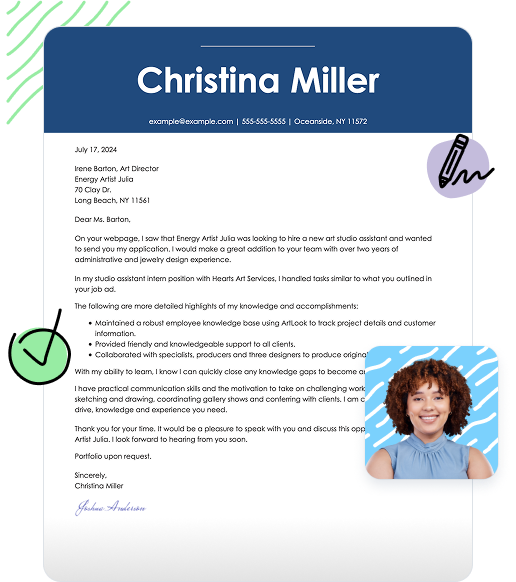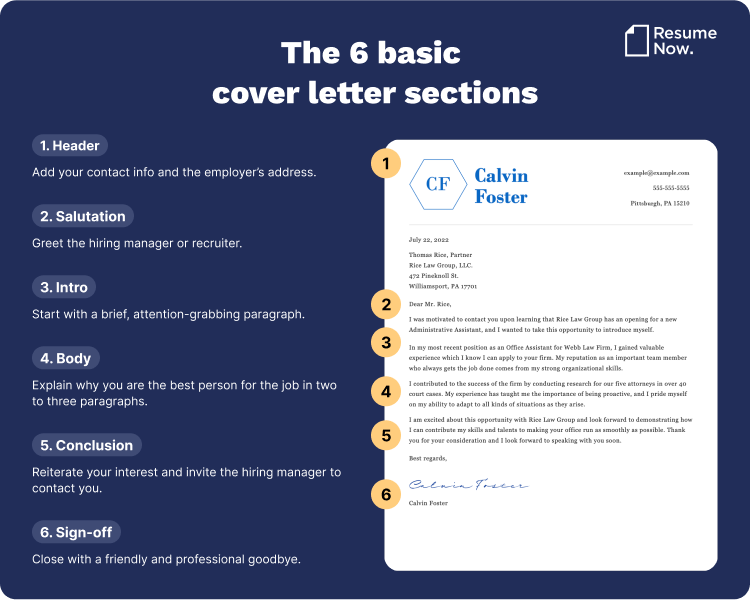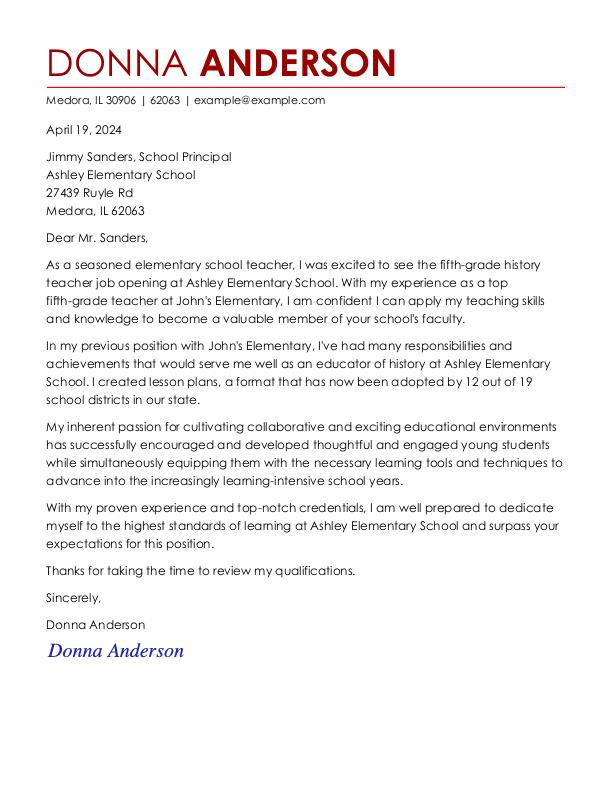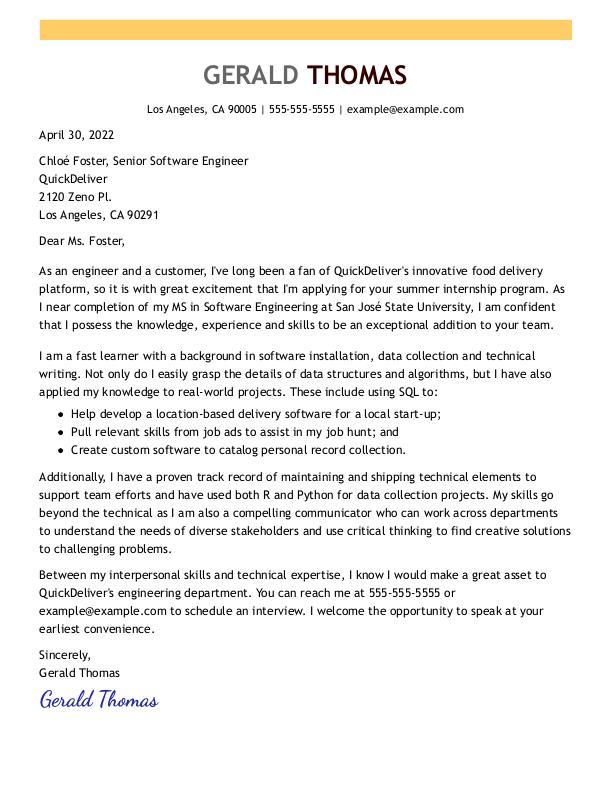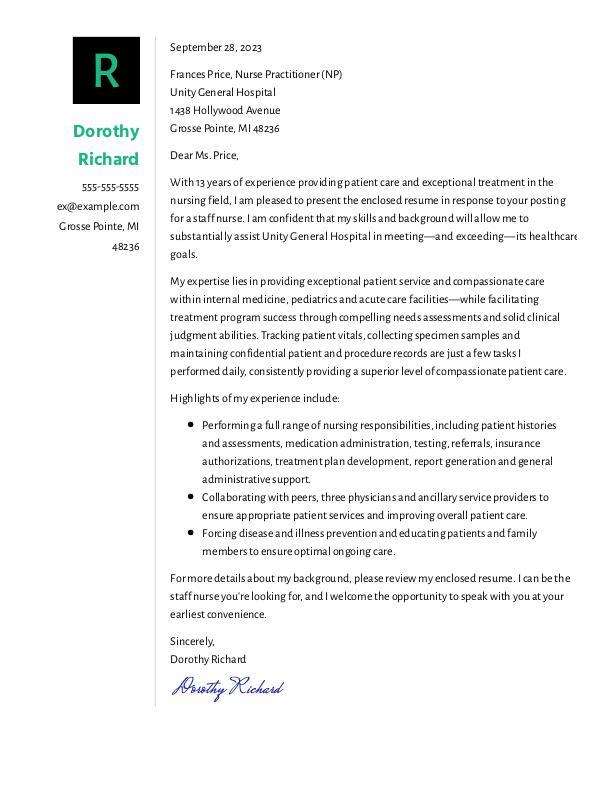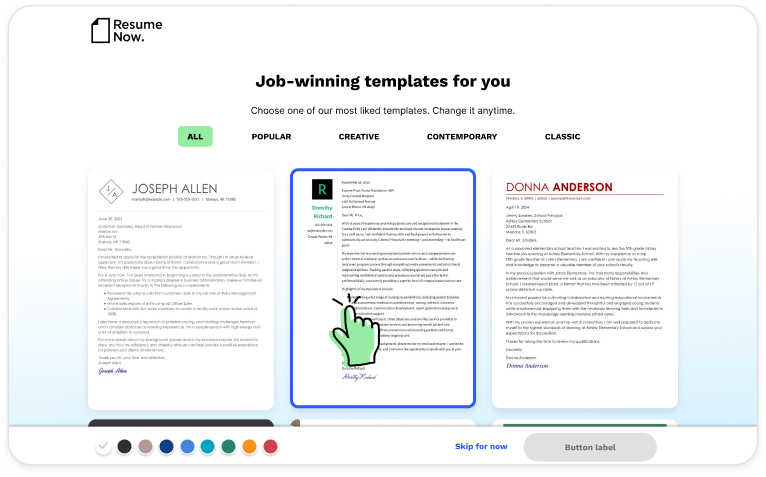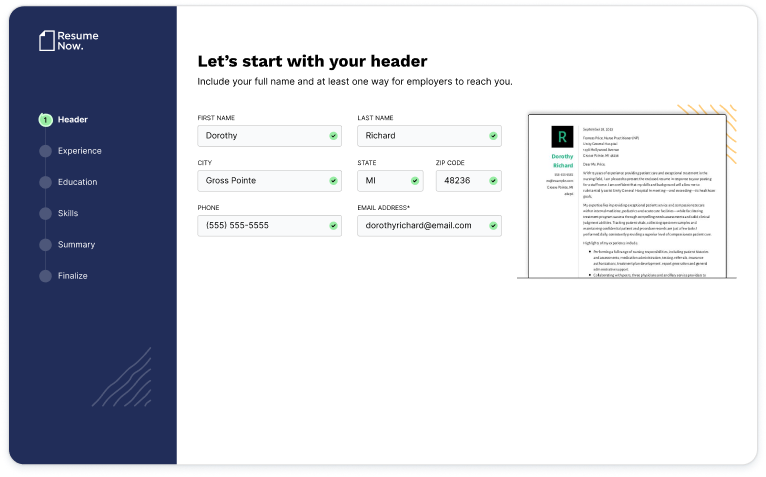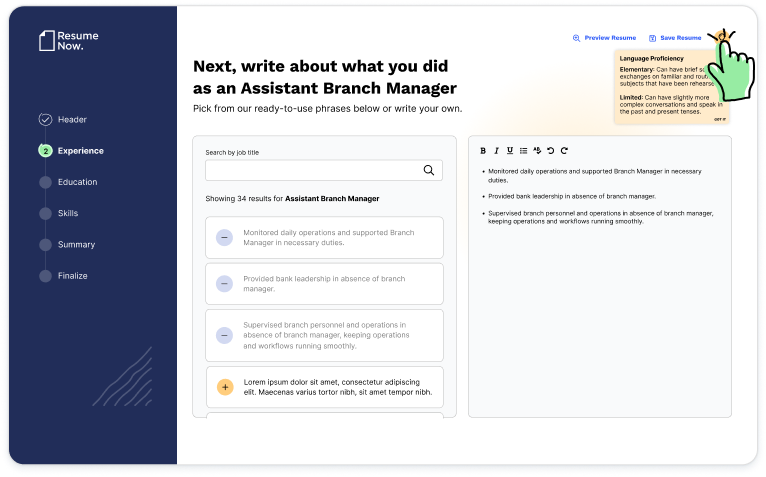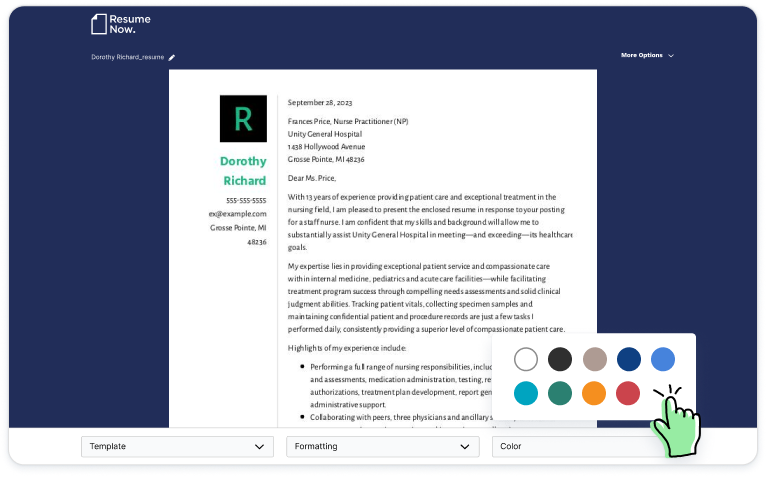Table of contents
- What Is a Cover Letter?
- How to Make a Cover Letter in 7 Simple Steps
- Pick a Template
- Add Your Contact Information in the Header
- Greet the Hiring Manager by Name
- Introduce Yourself in the First Paragraph
- Write Your Body Paragraphs
- Write Your Cover Letter Closing
- Sign Off
- 4 Great Cover Letter Examples
- 6 Cover Letter Tips
- Cover Letter Writing: Final Checklist
- How to Make a Cover Letter Using Our Builder
- How to Write a Cover Letter: FAQ
A great cover letter is a crucial step in your journey to land the job you've been dreaming of. It's your chance to make a strong first impression and bring the qualifications from your resume to life in detail.
That's why you need to learn how to write a cover letter that complements your resume and shows the hiring manager that you're the perfect fit for the role. We'll help you put together a letter that shows the employer how your skills, professional achievements, and work experience make you the best candidate for the role.
This comprehensive guide will show you:
- What a cover letter is
- How to write a cover letter in seven simple steps
- Great examples of cover letters for inspiration
- Tips for building a cover letter that stands out
- How to quickly and easily write a cover letter using our builder
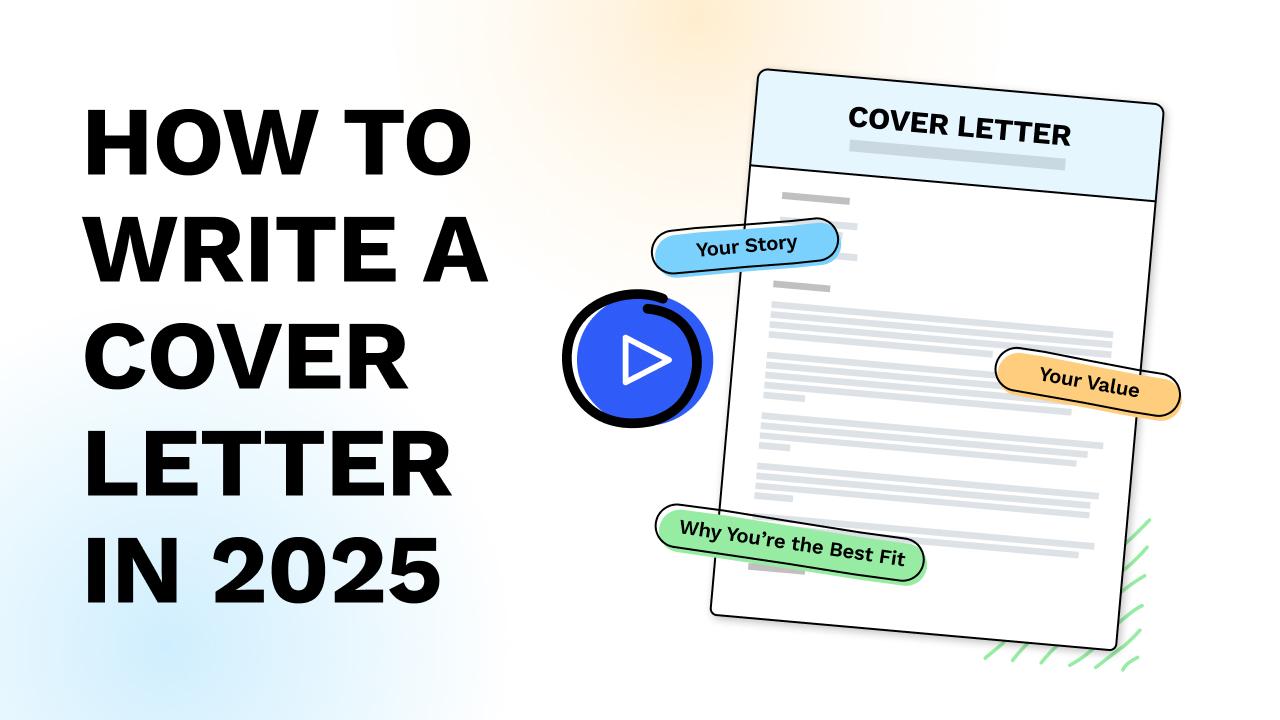
Ready to get started on your job-winning cover letter? Skip this guide and head to our AI Cover Letter Generator. This tool provides writing tips and suggested text based on your job and career history—and it only takes a few minutes.
What Is a Cover Letter?
A cover letter is a one-page business document that is submitted with a resume or a CV during the job application process. The purpose of a cover letter is to:
- Provide more details about your professional successes.
- Explain to potential employers why you want to work for them.
- Explain circumstances like resume gaps or career changes.
Submitting a strong job application first requires you to learn how to write a cover letter for a resume. The two documents should complement each other and act as two parts of an impressive application package. This means that writing a resume should come first. Then, your resume can act as a launchpad for the content of your letter.
When used as a companion to a resume, a cover letter is a valuable tool for you to introduce yourself to an employer and illustrate your skills, experience, and professional achievements.
Recruiters sort through huge stacks of applications. A great cover letter can make the difference between catching their eye and getting overlooked. Even with the perfect resume in hand, you can find yourself at the bottom of the pile. Don't let your qualifications go unnoticed! Earn that interview with a standout letter that illustrates your value.
What a great cover letter looks like
Before you start writing a cover letter, here is what a perfectly structured document looks like:
How to Make a Cover Letter in 7 Simple Steps
Learning how to write a cover letter for a resume is simple. Follow these steps and increase your chances of landing a job interview. Let's get started!
Step 1
Pick a Template
Cover letters look best on a professional template. That's why our designs are:
- Preformatted so that you can concentrate on your content
- ATS-friendly to ensure that your resume passes through applicant tracking systems
- Designed to complement our library of resume templates to help you create a cohesive application package
Browse our cover letter templates or jump directly into our Cover Letter Builder to find a style that suits you.
If you aren't ready to think about the design, that's okay. You can write your cover letter in a separate doc before you pick a template.
What do we mean by "make a cover letter for a resume?" In short, cohesion! Your cover letter should be your resume's wingman, and the two should look like they belong together. So, expand on aspects of your resume in your cover letter and select matching templates for consistency.
Step 2
Add Your Contact Information in the Header
The cover letter header can be at the top left, top right, or in the top center of the page, depending on which template you choose. It should include your:
- Full name
- City and state
- Phone number
- Email address
- Your LinkedIn profile or professional website if you have one
Your header must also contain the date you submit your application and the name, role, and address of the person you are writing to.
Here's how your header should look:
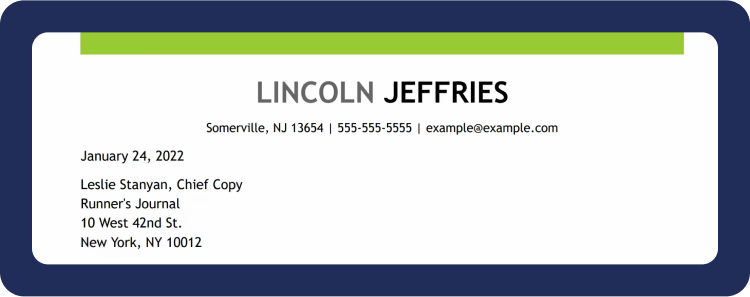
The contact information in your cover letter heading should be identical to the contact information you use for your resume. If you add a link to your portfolio or LinkedIn account on your resume, then add it to your cover letter, too.
Step 3
Greet the Hiring Manager by Name
You should always address the hiring manager or recruiter by name whenever possible. Sometimes a job ad will include the name and email address of the person who placed the ad.
If you don't know who to address it to, do some research to find the right name. Comb through the company's website, dig deep online, call the company, or use LinkedIn to learn the hiring manager's name and greet them like so:
"Dear Sam Smith," "Dear Dr. Kenney," "Dear Professor Liu." Never use informal greetings like "Hi," "Hello," or "Good morning."
If you can't find a name to address, then write a greeting like "Dear Sales Hiring Manager" or "Dear Sales Team."
Avoid using clichéd greetings like "To Whom It May Concern." This is polite enough, but too impersonal and stiff for a modern cover letter. Addressing your letter to the hiring manager's name or to the title itself strikes just the right balance.
Step 4
Introduce Yourself in the First Paragraph
Learning how to start a cover letter is critical to holding a recruiter's interest. Start strong with a cover letter introduction that shows your interest and enthusiasm for the role. Tell the employer who you are and why you're writing.
Here are examples of positive and enthusiastic cover letter opening lines:
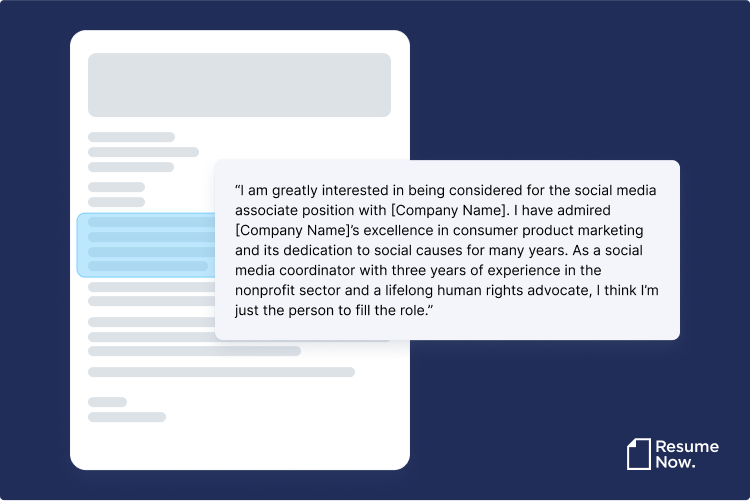
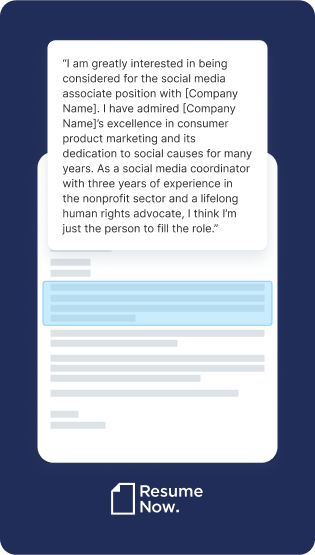
Opening paragraph for a social media role:
"I am greatly interested in being considered for the social media associate position with [Company Name]. I have admired [Company Name]'s excellence in consumer product marketing and its dedication to social causes for many years. As a social media coordinator with three years of experience in the nonprofit sector and a lifelong human rights advocate, I think I'm just the person to fill the role."
Opening paragraph for a technical writer role:
"I'm very interested in your job posting for a technical writer with [Company Name]. I am a methodical and detail-oriented professional with more than five years of experience as a technical writer for software companies in Silicon Valley. You will find that I have a track record of exceeding deadlines and improving workflows to ensure that projects run smoothly and efficiently. I'm sure my experience and varied skill set could benefit the position and [Company Name]."
Your cover letter introduction should be brief and get right to the point, leaving the rest of your letter for the details.
Step 5
Write Your Body Paragraphs
Your cover letter's body paragraphs should describe your experience in detail using metrics and specific outcomes. Describe your most relevant achievements, the reasons you're interested in the role, and your technical skills in a few concise paragraphs.
Here are a few tips for writing an enticing body paragraph:
Demonstrate your personality. Cover letters are meant to give employers a glimpse of the person behind the letter. Show them what makes you unique.
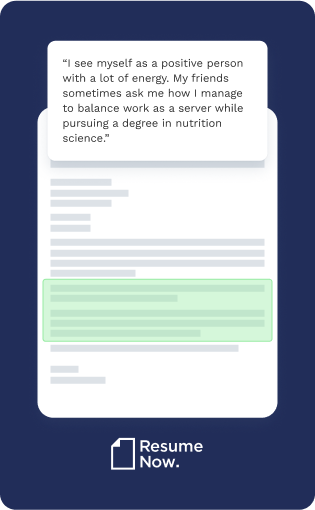
Describe specific aspects of your related experience. Part of this is calling out your most admirable and relevant achievements and briefly telling the stories behind them. Use specific outcomes and numbers to back them up wherever possible.
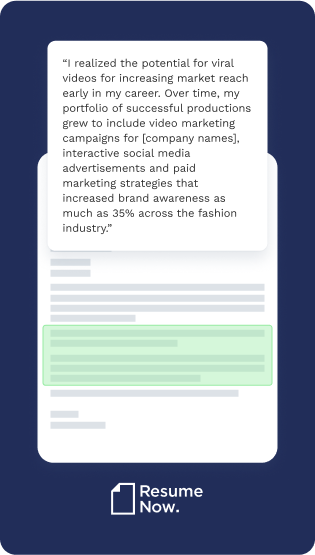
Highlight transferable skills. This is especially important for those candidates who are making a career change or who have little to no work experience. Use your cover letter to highlight the skills you possess that would be useful in the role you're applying for.
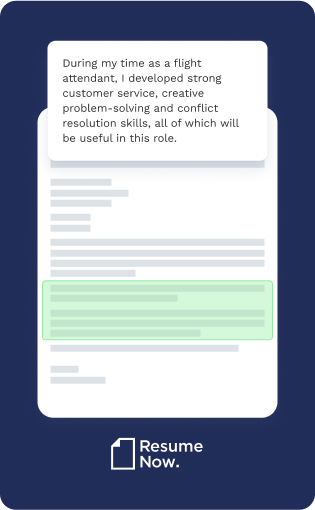
Explain gaps in your resume. These may include gaps from being laid off or fired, taking a break to raise children, or a string of short-term jobs. Addressing any unique circumstances gives you the chance to explain why those experiences add to your qualifications.
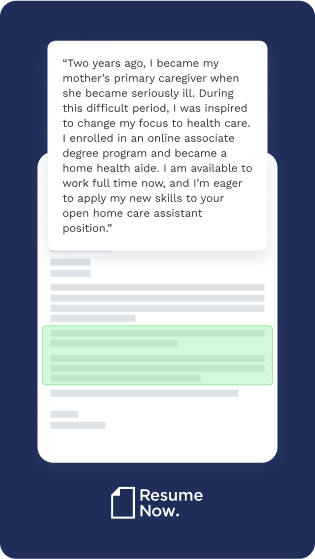
Always talk about your qualifications as they apply to the company's needs and not in terms of what you want to get out of the job. Emphasize how your skills have contributed to real-world results in past roles.
Here's how to highlight your key accomplishments and qualifications in a bullet-point list:
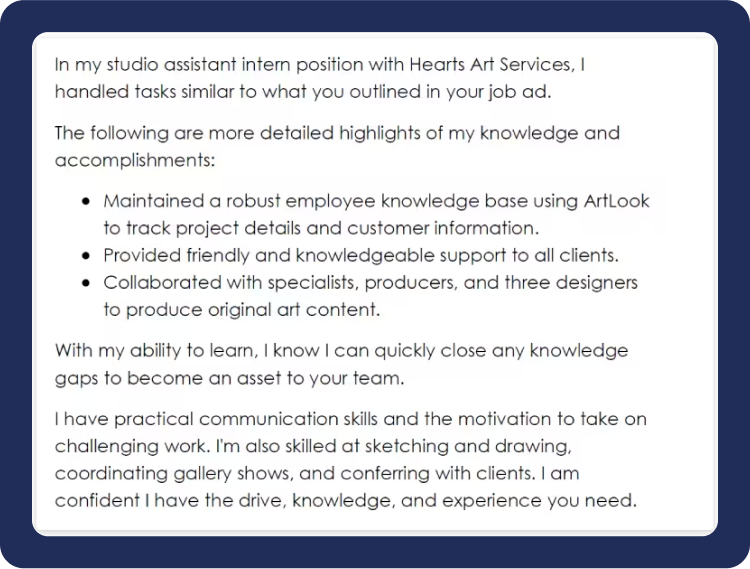
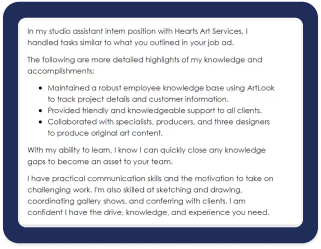
Step 6
Write Your Cover Letter Closing
A cover letter closing is where you reiterate your interest, thank the hiring manager for their time, and invite them to follow up with an interview. This section should be confident, assertive, and polite.
For example:
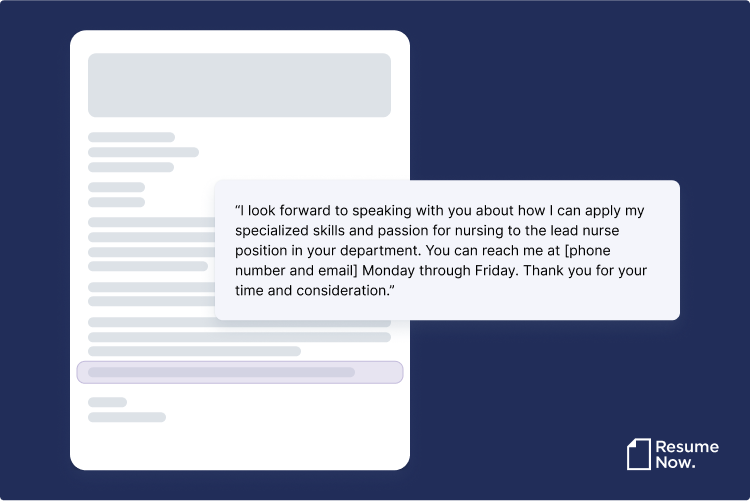
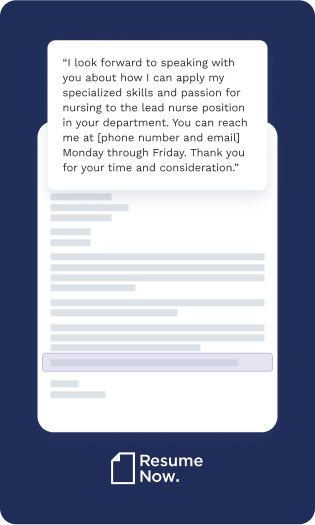
There's a fine line between inviting the hiring manager to connect and being pushy or desperate. Avoid statements like, "I really want this job, please contact me for an interview," and "I will call you tomorrow to discuss my qualifications."
Step 7
Sign Off
The signature is where you politely sign your cover letter. Popular signoffs include "Sincerely," "Thank you," and "Respectfully."
After your closing paragraph, add a line break, write your signoff, add another line break, and sign your full name.
Avoid informal signoffs, such as "Cheers," "Love," "Take care," or "Warmly," even if you know the hiring manager very well.
4 Great Cover Letter Examples
Reviewing sample cover letters is a great way to learn how to write your own.
Our cover letter examples demonstrate how to write a letter that will get you noticed by recruiters and hiring managers. And, with hundreds of letters to choose from, you'll be sure to find the right cover letter in our library. Here are four popular cover letter examples to review for inspiration:
Cover letter for a teaching job
Cover letter for an internship
Cover letter for a job with no experience
Cover letter for a nursing job
6 Cover Letter Tips
As you build your letter, review the following tips to ensure you have covered all the critical elements of a cover letter:
Tip #1
Convey knowledge about the company
Research is crucial when writing a cover letter. You must learn about the prospective employer so you can speak to how you're a possible match. Applicants who make an effort to find out more about a company and show this in their cover letter are preferred because they show commitment.
While conducting your research on how to make a cover letter, ask the following questions:
- What product(s) or service(s) does the company provide?
- What is the company culture? Do you feel you're a good match for their culture?
- What are the company's values, challenges, mission, and goals? Do you feel you could support them in achieving their mission and goals?
- Who are their competitors? If you're familiar with their competitors, it may be helpful to share this fact in your cover letter.
Tip #2
Tailor your message to a specific job and employer
Once you've done your research, you're ready to customize your cover letter for your target company. One way to do this is to tailor your skills to the job requirements and match your achievements to the tasks of the role.
Do this by studying the job description and adding a sentence or two that tells employers how you have used the required skills in the past. For example, if a job requires familiarity using WordPress, you can say: "I have six years of experience using WordPress and have the ability to read and write HTML."
Tip #3
Consider your audience
To make an impact, you've got to think about who will be reading your cover letter. Chances are, your letter will be read by:
- Applicant tracking systems (ATS). Many hiring managers and recruiters often use ATS software, which scans and sorts cover letters and resumes to weed out those that don't match a job's required skills and experience. To get past them, use keywords in your cover letter that best describe the company, the job description, and the position.
- Recruiters and hiring managers. Recruiters rate and rank candidates for interviews. They look for the "best of the best," scanning cover letters for achievements, awards, and unique skill sets. When writing your cover letter, be sure to emphasize your most relevant successes and how you can apply them to the job. Busy hiring managers want to see a well-thought-out cover letter that shows you understand the role, took the time to learn about the company, and have the qualifications necessary to perform the job.
Tip #4
Demonstrate your potential value
Ask yourself the following questions to make sure you have showcased your value:
- How would you help the company meet its goals? For instance, if a retail business or manufacturer wants to expand its sales operations, share examples of your related achievements in this area.
- How would you help to further their mission? If you want to work for a company because you know its purpose is to sell only sustainable products, mention your passion for environmental causes. If you volunteered for a green organization, weave that experience into your narrative.
- How would you help support the company's ethics, business, or values? For example, if you've learned that the company wants to expand its charitable outreach to nonprofit organizations and you've worked for nonprofits, definitely highlight this experience.
- How can you help them solve a problem? Demonstrate how you can provide a solution to a problem you may have discovered through your research.
Tip #5
Include as many specific details as possible
Employers want to know what you bring to the table. To show them your potential, include facts and figures about past accomplishments. You must convince prospective employers that you're a perfect fit for a role by providing related stories and anecdotes throughout your cover letter.
For example, how have you contributed to successful projects or initiatives? Did you create a new process that helped the team or the company be more efficient? Whatever it is that you've accomplished, adding specific details to your cover letter shows you have the experience and skills they're looking for and that you can bring that value to the role you're targeting.
Tip #6
Show your excitement about the job
Displaying sincere interest in the opportunity helps employers envision you in the role and creates a connection between you and the hiring manager.
Accomplish this by using action verbs, such as "motivated" and "thrilled," to emphasize your desire to work for the company. Use this language throughout your letter to give employers a strong sense of the energy and excitement that you would bring to the role.
Cover Letter Writing: Final Checklist
Be sure you've included all six critical sections of your cover letter.
Ensure you've added your header, salutation, introduction, body paragraphs, closing paragraph, and signoff.
Pick an appropriate cover letter template.
For conservative industries, choose a simple template. If you're applying for a role in a creative field, it's acceptable to choose a more design-heavy cover letter template. Just be sure your content is still the star!
Verify that your contact information is correct.
After all, a recruiter can't contact you for an interview if they can't reach you!
Review your opening paragraph.
It should be catchy and express enthusiasm. Tell the recruiter why this role excites you and what you'll bring to the table.
Make sure your body paragraphs are relevant and detailed.
Using bullet points in this section can help make your most impressive professional achievements pop. Make sure that you've used specific outcomes, examples, and metrics to describe your achievements.
Keep your formatting consistent throughout.
Choose a standard business-style font like Arial, Calibri, Verdana, or Times New Roman and use it throughout. Stick with an 11- or 12-point size to make it easy for most people to read.
How to Make a Cover Letter Using Our Builder
Our award-winning Cover Letter Builder makes it possible to create a well-written, customized cover letter for a resume in a matter of minutes.
Our cover letter maker does the work for you so that you can focus on the critical task of your job search: applying for your next great opportunity. Just follow these simple steps in our builder and start your job search today.
Choose a template
From conservative to creative, Resume Now's builder offers dozens of cover letter designs and color options for you to choose from.
Provide your contact information and desired job title
Just add your contact information and desired job title to get started.
Craft your letter
Writer's block will never be an issue when you use our Cover Letter Builder. Simply fill your letter with our job-specific content suggestions that are auto-generated for every section of your letter. Use the text as-is or customize it to make it your own.
Proofread your document
You've put in the effort to create a great cover letter—don't let typos or other errors ruin your final product. After checking your letter with our spell checker, proofread it or have a trusted friend give it a read. Then, make your final changes, and done!
When you're finished, download the file in whichever format you'd like, including PDF and Word. You can always come back and change the template, color, and details from your saved letter to apply for all the roles you want.
How to Write a Cover Letter: FAQ
Last Updated: July 21, 2025
Not always, but most of the time, a cover letter is necessary. Whether or not they are required, writing a cover letter is important because it allows you to expand on your resume and provide details about your background that aren't included in a resume.
Plus, cover letters allow you to create a strong narrative outlining why you are the best choice for the position. When you learn how to write a good cover letter, you significantly increase your chances of landing an interview.
If an employer specifically requests a cover letter and you don't provide one, chances are you will be rejected regardless of your credentials. In some cases, hiring managers don't require a cover letter, but that doesn't mean you shouldn't provide one.
Adding a cover letter shows effort and commitment and can set you apart from other applicants. Plus, an extra opportunity to communicate with the employer is always an asset.
Everyone is excited about AI these days, and it's easy to see why. Tools like ChatGPT and AI-powered cover letter builders can automate parts of the writing process and help inspire you with brand-new ideas.
AI can help you generate ideas and form a baseline for your letter, but fill in the specific ideas yourself. It's important that you ensure that your letter is specific and expresses your unique personality.
If you're really excited about making the most of AI tools, you may also want to look into AI resume builders. Just like with your cover letter, AI tools can help you build a stronger resume by blending your human creativity with the power of technology.
Try Resume Now's free AI Resume Review to assess the strength of your resume's content and structure with the power of AI.
Not always, but often yes. While there are differences between CVs and resumes, when it comes to cover letters, they should be treated the same way. When you make a CV, write a cover letter to provide additional information about why you're a good fit for the role and to show your enthusiasm for the job.
Only avoid sending a cover letter if the job ad specifies not to send one or if it's not part of the hiring process in your industry.
The best opening sentence for a cover letter is one that introduces you to the hiring manager and expresses your enthusiastic interest in the position. In addition to qualifications, recruiters look for applicants who express excitement about the role and what they will bring to the table.
A cover letter should be no more than one full page long, or about 450 words. Start your cover letter with a strong introduction, follow it with three or four concise paragraphs, and finish it with an attention-grabbing closer.
Here's how to make a cover letter sound great even if you are underqualified for the job you're applying for: Focus on your transferable skills and enthusiasm for the job. After all, the most impressive letters don't simply list qualifications; They paint a picture of a passionate applicant who will bring value to the team.
A cover letter should mention the job you want and express your sincere interest in the position you're applying for and the work the company does.
The body paragraphs should clearly and concisely explain why you're the best fit for the job and show real examples of how you can help the company succeed.
You can do this by highlighting past achievements and matching them to the job description. Get specific and focus on the real-world outcomes of your past work to make your skills stand out.
Finally, a cover letter closing should express sincere appreciation for the reader's time and convey enthusiasm and confidence. If you need more specific advice, check out our library of cover letter examples.
Writing a cover letter for a first job means navigating how to demonstrate your merit without any concrete work experience to back up your skills. Fortunately, you don't always need a lot of experience to get hired; passion and determination can go a long way.
You can also play up your skill set, class projects, and testimonials to build a compelling case for yourself. In short, show your relevant experience, even if it isn't from previous jobs.
Create a cover letter online with the help of Resume Now's Cover Letter Builder. Use the powerful editor, its auto-generated content suggestions, and beautiful, professional templates to make an effective cover letter in no time.
Every cover letter must include the following:
- A cover letter heading with the applicant's and the prospective employer's contact information
- A salutation to address the cover letter to the reader
- An introduction paragraph that captures the reader's attention
- Three or four body paragraphs that show why you're the best candidate for the role
- A closing paragraph that reiterates your interest, thanks the reader for their time, and invites them to follow up with you for an interview
- A signoff where you professionally and politely close the letter, such as "Sincerely" and "Thank you"
Heather is the Content Strategy Manager for Resume Now and a Certified Professional Resume Writer (CPRW) with more than ten years of experience writing about job search and career topics. She is based in San Francisco.
More resources

How to List Excel Skills on Your Resume (40+ Examples, Definition & Tips to Improve)
Learn how to list Excel skills on your resume with our guide f...

What If No One Responds When You Try To Follow Up After a Job Interview?
If no one responds after you try to follow up after a job inte...

How to List Adaptability Skills on Your Resume (35+ Examples, Definition & Tips to Improve)
Our adaptability skills definition and guide will help you wri...
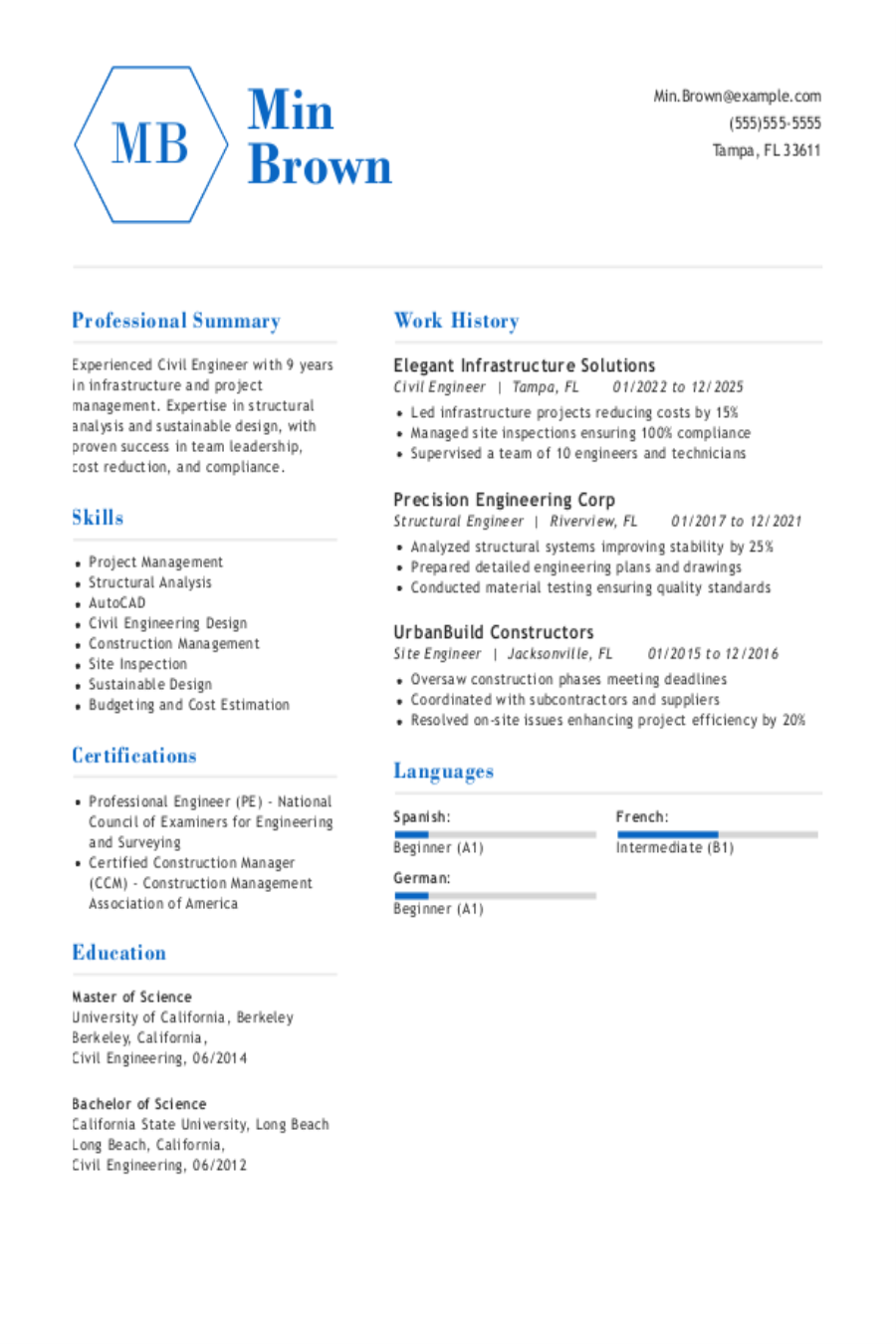
Civil Engineering Resume: Examples & Templates
Heather O Neill CPRWCareer Expert Heather is the Content Stra...

Interview-Winning Child Care Resumes Examples and Tips
Heather O Neill CPRWCareer Expert Heather is the Content Stra...
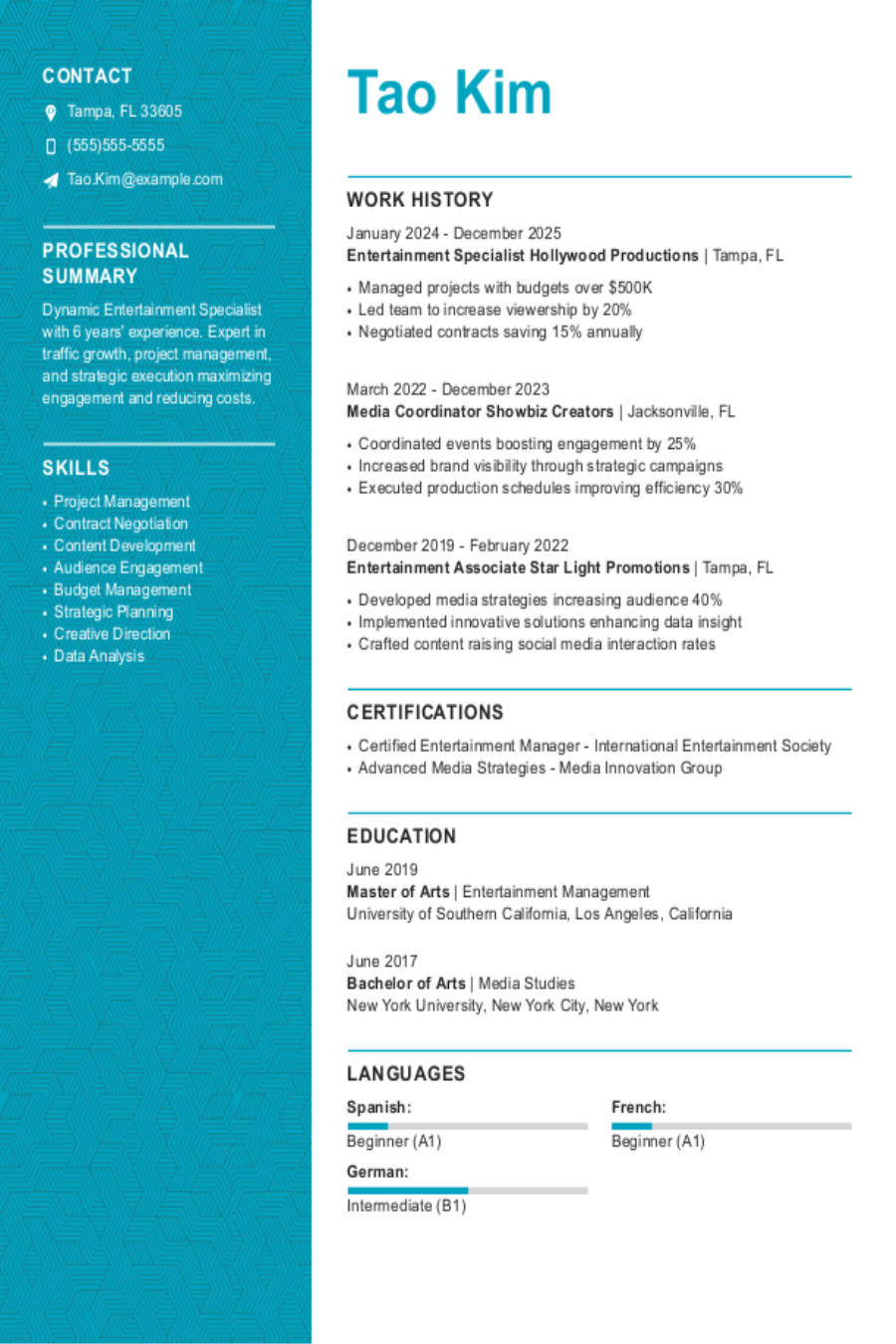
Interview-Winning Entertainment Resumes Examples and Tips
Heather O Neill CPRWCareer Expert Heather is the Content Stra...

